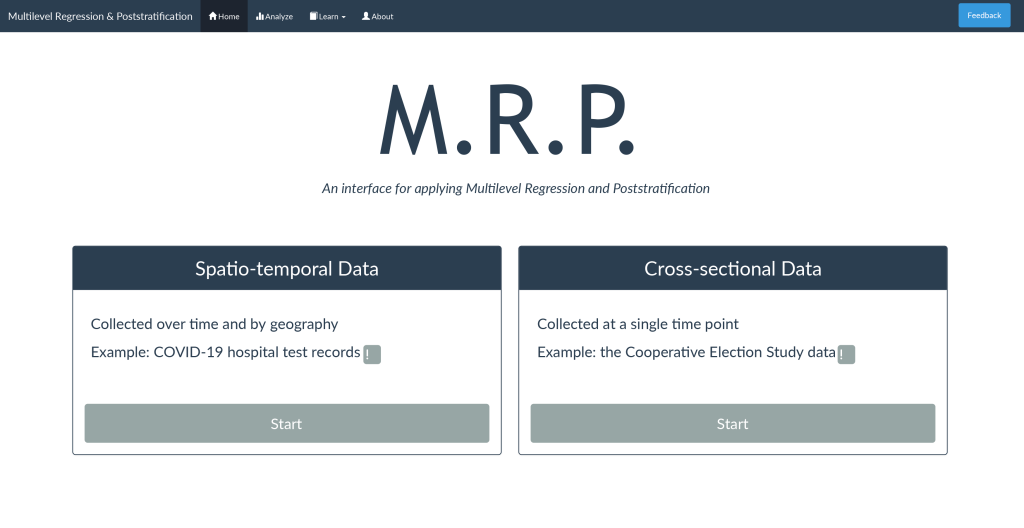MRP: An analytic interface to generate model-based county-level estimates of COVID-19 transmission
Principal Investigator

Yajuan Si
Research Associate Professor, Institute for Social Research, University of Michigan
Co-Investigators
- Leonard Covello, Otolaryngologist, Community Health Hospital
- Jonah Gabry, Staff Associate, Institute for Social and Economic Research and Policy, Columbia University
- Andrew Gelman, Professor, Department of Statistics; Professor, Department of Political Science, Columbia University
- Katherine Li, Research Assistant, Institute for Social Research, University of Michigan
- Mitzi Morris, Staff Associate, Institute for Social and Economic Research and Policy, Columbia University
- Toan Tran, Research Software Engineer, Institute for Social Research, University of Michigan
- Jon Zelner, Associate Professor, School of Public Health, University of Michigan
Funded By
National Institute on Minority Health and Health Disparities (NIMHD)
The problem:
Throughout the COVID-19 pandemic, health departments across the country relied on testing data to determine viral incidence rates. However, this approach had several limitations. First, surveillance systems primarily detect symptomatic cases. Second, the increased use of at-home tests caused many positive results to go uncounted. Such limitations may have caused the United States to inaccurately understand transmission trends.
To better estimate COVID-19 transmission trends, Si and colleagues aim to:
• estimate the virus infection incidence and naturally- and vaccine-acquired immunity prevalence in the community and across subgroups,
• examine health disparities with respect to asymptomatic and symptomatic patients, the social pathways to disparities, and how these discrepancies may interactively impact the socio-demographically dependent spread of disease, and
• develop a web-based interface to make adjustment procedures publicly available.
The approach:
This study leveraged viral RNA COVID-19 test results of asymptomatic patients undergoing elective medical procedures. Because hospitals tested all of these patients before procedures, the team hypothesized that these test results can be used as a proxy for random asymptomatic COVID-19 testing.
The team assumed that within a given demographic group, the ratio of symptomatic to asymptomatic cases stays the same over time. They posit that changes in test positivity among asymptomatic individuals would predict changes in symptomatic PCR-detected infections with a temporal delay. Thus, trends in asymptomatic infections provide a better understanding of the behavior of the virus within the community as a whole.
Residential ZIP codes for elective procedure patients were linked to American Community Survey data to define the target population and obtain socio-demographic and geographic measures—like poverty level, median household income, and employment rates—of the target population.
The team then applied the multilevel regression and poststratification (MRP) method to match the demographic composition of the COVID-19 test data to the population and estimate actual COVID-19 prevalence.
Producing a public online interface:
A comparison of observed versus estimated positivity rates across Michigan illustrates how MRP can improve county-level estimates of prevalence. Results indicated that while raw positivity rates in some counties varied between zero and one percent, the estimated prevalence for these counties varied between zero and seven percent, suggesting that actual community prevalence was different from observed positivity rates due to a small number of tests.
Additionally, the team examined disparities in infection in White and non-White populations in Indiana and Michigan. They found that non-White populations tended to have higher ratios of asymptomatic to symptomatic COVID infections compared to White groups, indicating racial disparities.

A screenshot of the interface designed by the research team for applying Multilevel Regression and Poststratification.
Selected Publications & Presentations
Si, Y., Tran, T., Gabry, J., Morris, M., & Gelman, A. (2024). Multilevel Regression and Poststratification Interface: Application to Track Community-level COVID-19 Viral Transmission. https://doi.org/10.48550/ARXIV.2405.05909